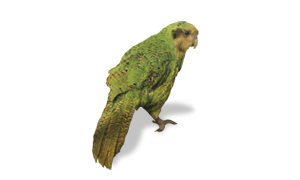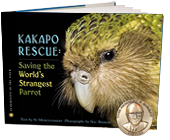Kakapo Rescue: Saving the World’s Strangest Parrot
(Scientists in the Field Series)
Houghton Mifflin Books for Children, ISBN 978-0618494170
“…In a companion book , “Kakapo Rescue: Saving the World’s Strangest Parrot,” Montgomery gives us what could have been chapter eight of ‘Birdology.’ ‘Kakapo’ is intended for readers ages 7 to 10. Released at the same time, although by a different publisher, the book details the efforts to prevent the extinction of these giant New Zealand parrots. Heavy, friendly, sweet-smelling and unable to fly, these human-loving birds were once common. Now the fewer than 100 that remain are being re-introduced on the predator-free Codfish Island, off the southern coast of New Zealand.
Montgomery and photographer Nic Bishop show readers the scientists and a group of dedicated volunteers who work diligently on a project that may, or may not, be successful.
A fascinating report with stunning pictures, this book will appeal to adults as much as children.
If you buy one of these books, look for the other. They really do go together.”
—C.F. Foster for the Florida Times-Union
“Once common in New Zealand, the kakapo, a large flightless green bird, suffered from humans and human-introduced species to the point that it was once believed extinct, and the species still numbers under 100 individuals. The National Kakapo Recovery Team, a dedicated group of volunteers and professionals, now monitors every bird, supports every egg, and nurtures every chick in the hope of preserving this unusual species. Montgomery and Bishop, off on one of their usual exotic adventures, join the team on remote Codfish Island, where they follow Lisa, a kakapo mother, and her newborn chick. It’s a dramatic story of preservation attempts at the very brink of extinction, and the tension, excitement, and fragility of the situation is made crystal clear, with the team rejoicing at every gain and mourning setbacks (including the sudden and unexpected loss of Lisa’s chick.) The devotion of the team is palpable, and the point is made but not belabored that a number of these dedicated individuals came from other walks of life to work for this particular cause; it’s also humblingly clear they are to some extent feeling their way. While photographer Bishop could probably make a teenager’s room like like an alluring ecosystem, Codfish Island is stunningly attractive in these images, with the kakapo themselves an enchanting luminous green that blends, with ludicrous beauty, into the verdant ferns and mosses of the forest flour. The glamour shots are balanced by documentary images of the travel necessities and the team’s home base, which together give an impressively complete picture of the enterprise and its subject. More han most books about environmentalism or endangered species, this will encourage kids to consider how hands-on action can genuinely make a difference and how scientific contributions can be made by people who never go near a test tube. A quick postscript, information about donating to kakapo preservation, and a bibiliography are appended, as is an index.”
—The Bulletin of The Center for Children’s Books, Starred Review
“Take a parrot. Color it green. Give it soft, fluffy feathers, and whiskers. Give it sumo proportions and take away its power of flight. Make it nocturnal, and have it nest underground. Aha! A kakapo! Once millions of these rather affable birds waddled all over New Zealand. Reduced (at present) to fewer than 90, the kakapo have been isolated on Codfish Island (free of feral cats, weasels, and stoats—all introduced species) and are now under the strict, careful guardianship of the New Zealand National Kakapo Recovery Team. Montgomery and Bishop were granted 10 days in which to accompany members of the team (many volunteering their time and efforts) as they radio-tracked the birds night and day in their forest habitat, weighed chicks, watched nesting behavior through hidden cameras, and plowed through gale-force winds and torrential rain to monitor the well-being of their charges. Excellent photos and a readable, conversational text provide an intimate look at a concerted effort to save a drastically endangered species unfamiliar to most of the world outside Down Under. Readers who enjoyed this author/photographer team’s The Tarantula Scientist (2007) or Quest for the Tree Kangaroo (2006, both Houghton) will gobble up this tribute to ecological science in action.”
—Patricia Manning, formerly at Eastchester Public Library, NY, for School Library Journal
“Sy Montgomery and Nic Bishop, whose highly lauded titles include two Sibert Honor Books, offer yet another winning entry in the Scientists in the Field series. This time, the intrepid duo heads to a remote island off the southern tip of New Zealand, where they join a local government-sponsored research team that is working to save the Kakapo parrot from extinction. Weighing in at nearly nine pounds, these beautiful, honey-scented, once-ubiquitous creatures, named ‘the most wonderful of all living birds’ by a nineteenth-century naturalist, have become a symbol of human civilization’s devastating effects on indigenous life, and the New Zealand government is directing significant resources to try to ensure the species’ survival. As usual, Montgomery’s delight in her subject is contagious, and throughout her enthusiastic text, she nimbly blends scientific and historical facts with immediate, sensory descriptions of fieldwork. Young readers will be fascinated by the incredible measures that the passionate workers follow to help the new birds hatch, and many will share the team’s heartbreak when some chicks die. Bishop’s photos of the creatures and their habitat are stunning; an awe-inspiring, closing image of the world’s eighty-seventh known Kakapo emerging from its shell captures the miracle of birth, for any species. Like many of the team’s previous titles, this offers excellent support for units about animal conservation.”
—Gillian Engberg for American Library Association’s BOOKLIST
“Under the careful supervision of forest rangers and volunteers on an island off the New Zealand coast, the nearly extinct, flightless Kakapo parrot is the object of an intensive rescue effort described by this experienced writer-photographer team. Montgomery and Bishop waited five years for the opportunity to visit Codfish Island to document this work. They’ve hatched a fascinating account of their all-too-short but eventful stay. The author’s well-organized narrative includes information about the parrots’ habits, their near disappearance and current island habitat and the activities of those who monitor each individual parrot through occasional physical capture and daily radio telemetry observations, watch nests and provide supplemental food. Describing triumph and tragedy, she movingly conveys the magic of the forest and of an accidental encounter with a parrot in the wild. As always, the photographer’s remarkable and clearly reproduced photographs support and enhance the text. The book’s careful design is unobtrusive: The progress of an opening egg sets off page numbers, and fern patterns provide a subtle decoration. Bibliography and a website encourage readers’ further explorations. Wonderful.”
—Kirkus Reviews
“Targeted for a fourth- to sixth-grade audience, ‘Karkapo Rescue’ should appeal to adults as well as young people. It’s an amazing story and a fascinating look at the lives of dedicated scientists and volunteers determined to save a species threatened with extinction.”
—Charleston Gazette

